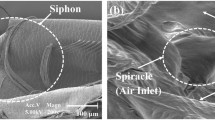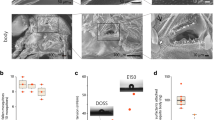Abstract
THE emergence of resistant species and an increased awareness of the environmental problems associated with the use of insecticides has resulted in a search for alternative methods of mosquito control1. One possibility is lecithin (phosphatidylcholine), which is lethal to the pupae of many species of mosquito and to some fourth stage larvae, when spread as a monomolecular layer at high surface pressure on the air–water interface2,3. Other analogous water-insoluble surfactants, such as cetyl, stearyl and oleyl alcohol ethers of ethylene glycol are equally effective, and successful trials using several of these monolayers have been carried out on rice fields in Kenya4. These have not, however, thrown much light on the mechanism of the anoxic process. Observations by high-speed photography suggested that it is not simply a decrease in surface tension, with consequent wetting of the respiratory trumpet of the insect, but also involves a physical barrier to surface penetration (demonstrated in a 35-mm film available from A.I.M.). We report here the importance of the rheological nature of the monolayer, and show that those exhibiting ‘liquid’ properties at high concentrations form efficient barriers while ‘solid’ monolayers do not. We suggest that liquidity at high surface pressure enables (1) rapid repair of the monolayer after penetration or other disturbance; (2) rapid monolayer transfer to the penetrating trumpet during its displacement from the surface followed by ‘wetting’ and the formation of a bilayer-stabilised water ‘plug’, and (3) complete coverage of the water catchment surface in spite of, for example, projecting vegetation.
Similar content being viewed by others
References
Mosquito Control, Some Perspectives for Developing Countries (National Academy of Sciences, Washington DC, 1973).
Eckstein, F. Z. Hyg. Zool. Schädlingsbek 31, 191 (1939); ibid 237 (1939).
McMullen, A. I. & Hill, M. N. Nature 234, 51 (1971).
McMullen, A. I. MRC Annual Reps 63 (Medical Research Council, London, 1972–73).
Phillips, M. C. Prog. Surface Membrane Sci. 5, 139 (1972).
Phillips, M. C. & Hauser, H. J. Colloid Interface Sci. 49, 31 (1974).
Brooks, J. H., Mingins, J. & Owens, N. F. J. Colloid Interface Sci. (in the press).
Phillips, M. C. in Water. A Comprehensive Treatise 5 (ed. Franks, F.) 133 (Plenum, New York, 1975).
Green, J. P., Phillips, M. C. & Shipley, G. G. Biochim. biophys. Acta 330, 243 (1973).
Reiter, P. Mosquito News (in the press).
Author information
Authors and Affiliations
Rights and permissions
About this article
Cite this article
McMULLEN, A., REITER, P. & PHILLIPS, M. Mode of action of insoluble monolayers on mosquito pupal respiration. Nature 267, 244–245 (1977). https://doi.org/10.1038/267244a0
Issue Date:
DOI: https://doi.org/10.1038/267244a0
- Springer Nature Limited
This article is cited by
-
Acoustic tracheal rupture provides insights into larval mosquito respiration
Scientific Reports (2020)
-
Spreading of Bacillus thuringiensis var. israelensis over the water surface by a monolayer carrier
World Journal of Microbiology & Biotechnology (1991)
-
Current problems in the control of mosquitoes
Nature (1978)





